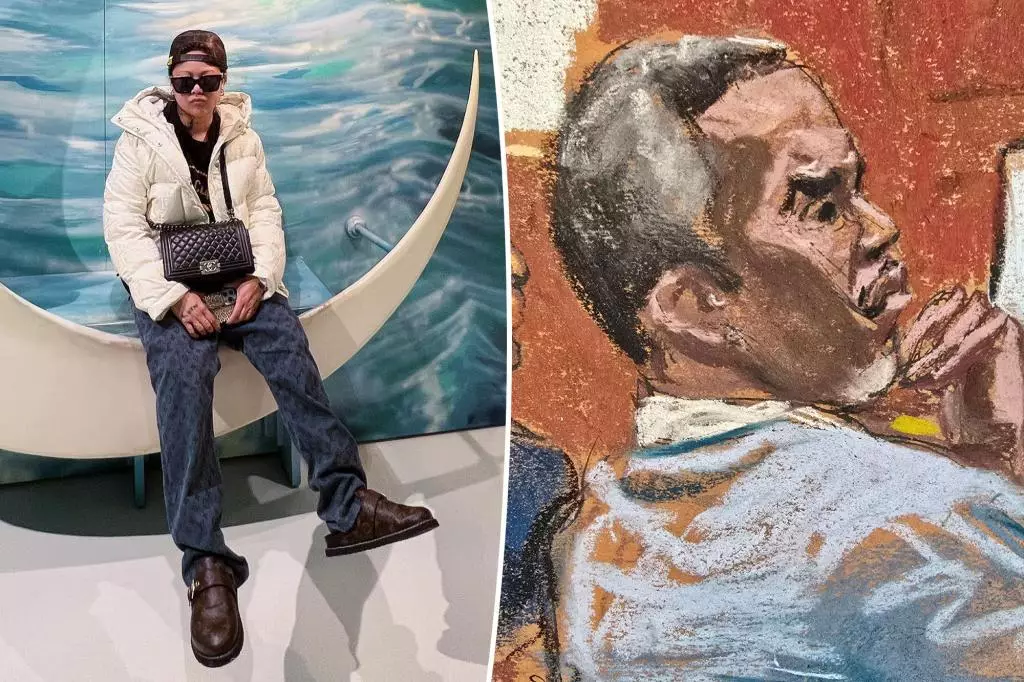In a shocking testimony that reverberated through the Manhattan federal courtroom, fashion designer Bryana “Bana” Bongolan recounted an incident that could only be described as a horror movie moment. During her testimony, she alleged that Sean “Diddy” Combs hung her over the balcony of his former girlfriend Casandra “Cassie” Ventura’s high-rise condominium back in September 2016. Weighing in at a mere 110 to 115 pounds and standing just 5-foot-1, Bongolan’s vulnerability was striking against the imposing figure of the music mogul. Her claims that she was physically lifted and dangled over the edge sent chills through the packed courtroom, drawing gasps from observers.
Bongolan’s assertion that she heard Diddy shout, “You know what the f*** you did,” before being roughly thrown onto balcony furniture makes one question how far the illusion of celebrity status can go. This display of rage was frightening enough to leave long-lasting psychological scars, as evidenced by Bongolan’s own admission of suffering from “night terrors” and “paranoia” post-incident. The depth of her trauma raises critical concerns about the impact of such violent acts on victims. For Bongolan, the struggle has extended beyond the physical to a torturous mental state that continues to haunt her.
The Unraveling Pattern of Violence
Bongolan’s testimony did not merely shake the courtroom; it also highlighted a troubling pattern of violent behavior allegedly exhibited by Combs. She revealed that this wasn’t an isolated incident but rather a part of a broader tapestry of intimidation and aggression that characterized Combs’ interactions. Her claim that Diddy once drew close to her face and asserted, “I’m the devil and I could kill you,” underscores a chillingly cavalier attitude towards life and death, particularly for someone positioned as a leader in the entertainment industry.
These claims were further substantiated by additional testimony from other victims, including Cassie Ventura herself, who recounted multiple incidents of physical abuse at the hands of Combs. The case paints a grotesque portrait that raises broader questions about accountability in the world of fame, especially as other witnesses corroborate Bongolan’s account of Diddy’s explosive temperament. These revelations challenge the notion of celebrity worship, forcing society to confront whether it enables such dangerous behaviors through its adulation of artists and moguls.
A Legal Battle for Justice
Currently, Bongolan’s ongoing legal battle includes a lawsuit against Combs for sexual battery and false imprisonment, demanding damages of $10 million. Combs has staunchly denied these allegations, with his legal team expressing unwavering confidence in their ability to dismiss the charges as meritless. This tug-of-war in the judicial arena showcases not only the personal plight of a woman seeking justice but also the conflicting narratives surrounding an influential figure embroiled in a scandalous spotlight.
The ramifications are profound, as Bongolan’s pursuit of justice takes on the weight of systemic issues surrounding domestic violence, power dynamics, and the treatment of women in both personal and professional settings. In a climate increasingly receptive to discussions about harassment and assault, her courage to come forward serves as a catalyst for others who may be suffering in silence.
Culture of Silence and Moving Forward
This chilling case illustrates not only individual trauma but also illuminates a broader “culture of silence” that often protects powerful men from the consequences of their actions. As more victims step forward, the public’s response grows increasingly urgent. The notion of celebrity cannot continue to render life-threatening behavior acceptable. The opportunity for a reality check is now, igniting crucial discussions around domestic violence, mental health, and the inherent dangers of celebrity culture.
Bongolan’s testimony transcends the courtroom. It echoes a rallying cry for accountability in an industry that has long turned a blind eye to abusive behaviors. The path to healing may be riddled with challenges, but the fervent pursuit of justice and the breaking of silence can offer hope and perhaps catalyze policy changes that protect vulnerable individuals from exploitation and violence.
As the legal battles unfold, both Bongolan and Combs remain locked in a high-stakes confrontation that is not merely about the outcome of a lawsuit but reflects a society’s reckoning with its darker truths, forever changing the landscape of fame and accountability.
